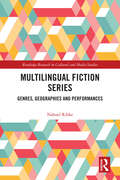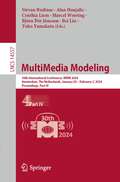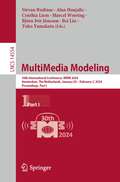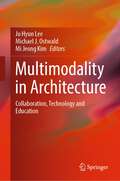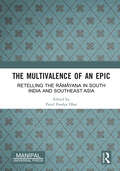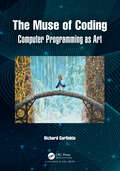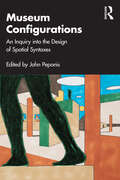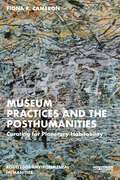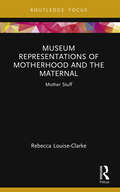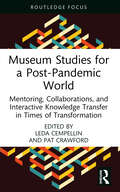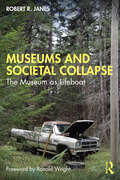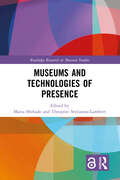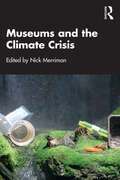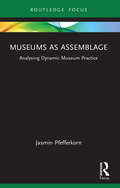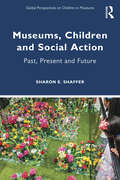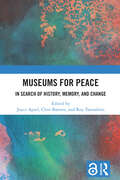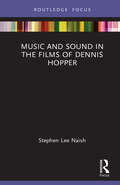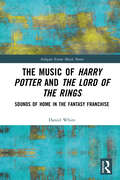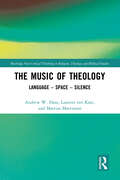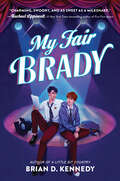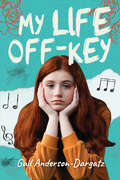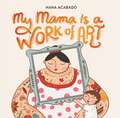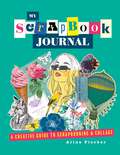- Table View
- List View
Multilingual Fiction Series: Genres, Geographies and Performances (Routledge Research in Cultural and Media Studies)
by Nahuel RibkeThis book explores the emergence and development of multilingual fiction series, a relatively new phenomenon propelled by the globalization of media industries and the consolidation of streaming platforms as central vectors in the production and consumption of audiovisual entertainment content. Through a detailed analysis of thriller, sitcom, and drama series, the book proposes an original qualitative and quantitative research methodology for the study of on-screen multilingual encounters, examining the relationship between multilingual speech and genre conventions. The book covers fiction series beyond English-speaking countries: alongside American productions, the analysis covers TV shows from Europe, Latin America, and the Middle East region. This interdisciplinary and original volume will interest scholars and students in film studies and media studies working on global media, as well as communication studies, television studies, sociolinguistics, media and cultural industries, and translation studies.
MultiMedia Modeling: 30th International Conference, MMM 2024, Amsterdam, The Netherlands, January 29 – February 2, 2024, Proceedings, Part IV (Lecture Notes in Computer Science #14557)
by Stevan Rudinac Alan Hanjalic Cynthia Liem Marcel Worring Björn Þór Jónsson Bei Liu Yoko YamakataThis book constitutes the refereed proceedings of the 30th International Conference on MultiMedia Modeling, MMM 2024, held in Amsterdam, The Netherlands, during January 29–February 2, 2024.The 112 full papers included in this volume were carefully reviewed and selected from 297 submissions. The MMM conference were organized in topics related to multimedia modelling, particularly: audio, image, video processing, coding and compression; multimodal analysis for retrieval applications, and multimedia fusion methods.
MultiMedia Modeling: 30th International Conference, MMM 2024, Amsterdam, The Netherlands, January 29 – February 2, 2024, Proceedings, Part I (Lecture Notes in Computer Science #14554)
by Stevan Rudinac Alan Hanjalic Cynthia Liem Marcel Worring Björn Þór Jónsson Bei Liu Yoko YamakataThis book constitutes the refereed proceedings of the 30th International Conference on MultiMedia Modeling, MMM 2024, held in Amsterdam, The Netherlands, during January 29 – February 2, 2024.The 112 full papers included in this volume were carefully reviewed and selected from 297 submissions. The MMM conference were organized in topics related to multimedia modelling, particularly: audio, image, video processing, coding and compression; multimodal analysis for retrieval applications, and multimedia fusion methods.
Multimodality in Architecture: Collaboration, Technology and Education
by Ju Hyun Lee Michael J. Ostwald Mi Jeong KimThis book examines multimodality in architecture and its impacts on collaborative, technical and educational processes or systems. Multimodality is becoming increasingly critical in contemporary architectural practice and education. Creative design teams face new challenges when they embrace new modes of communication, technology, and knowledge development processes. From diverse online modes of communication to shared digital environments, generative AI and advanced hardware solutions, new modes of information creation, sharing, and application are changing the ways architects and designers work.The book presents new research which empowers international researchers and designers to work more effectively in a diverse range of digital environments.Whether the readers are architects, teachers, students, or scholars, this book provides critical insights and practical tools for understanding and optimising processes in architecture and design.
The Multivalence of an Epic: Retelling the Rāmāyaṇa in South India and Southeast Asia
by Parul Pandya DharThis volume examines The Rāmāyaṇa traditions of South India and Southeast Asia. Bringing together 19 well-known scholars in Rāmāyaṇa studies from Cambodia, Canada, France, India, Indonesia, Malaysia, Singapore, Thailand, UK, and USA, this thought-provoking and elegantly illustrated volume engages with the inherent plurality, diversity, and adaptability of the Rāmāyaṇa in changing socio-political, religious, and cultural contexts. The journey and localization of the Rāmāyaṇa is explored in its manifold expressions – from classical to folk, from temples and palaces to theatres and by-lanes in cities and villages, and from ancient to modern times. Regional Rāmāyaṇas from different parts of South India and Southeast Asia are placed in deliberate juxtaposition to enable a historically informed discussion of their connected pasts across land and seas. The three parts of this volume, organized as visual, literary, and performance cultures, discuss the sculpted, painted, inscribed, written, recited, and performed Rāmāyaṇas. A related emphasis is on the way boundaries of medium and genre have been crossed in the visual, literary, and performed representations of the Rāmāyaṇa. Print edition not for sale in South Asia (India, Sri Lanka, Nepal, Bangladesh, Pakistan and Bhutan)
The Muse of Coding: Computer Programming as Art
by Richard GarfinkleThis book gives students and experienced programmers a way to see coding as an art and themselves as artists whose personal views, experiences, and ways of thinking can make their programs better for themselves and their users.This book shows in a good-humored and sympathetic way how the artistic and practical sides of programming are the same, delving into the methods of coding, the history of art, and the ways in which artists and audiences interact and benefit each other.Not confined to a single language or style of coding, this book provides a widely applicable framework for people to learn what languages and styles work best for them at present and as the field evolves. It can be used as a classroom text or for personal study and enrichment.
Museum Configurations: An Inquiry Into The Design Of Spatial Syntaxes
by Peponis, Edited by JohnMuseum Configurations demonstrates how museum space functions cognitively and communicatively and questions whether it can be designed to provide a rich embodied experience, situating displays and their public in felicitous dialogue. Including contributions from authors working in the disciplines of architecture, psychology, museum studies, history and the visual arts, this volume addresses an interdisciplinary audience. The analysis of a wealth of examples shows how the voices of architects, curators and exhibition designers enter into dialogue and invite visitors to make their own connections between physical, cognitive and affective space. Considering how the layout of museums facilitates movement and orientation so that visitors may devote their attention to displays, the book questions what kinds of visual attention characterizes museum experiences and how the design of museum space can support them. In the context of an often dematerialized, atomized, and dissipating contemporary culture, the book proposes that museums can function as shared space that supports enjoyment and learning without being overly didactic. Museum Configurations focuses upon the functions and aims of the design of space. This makes the book particularly interesting to academics and students working in exhibition design and museum architecture, as well as to exhibition designers, curators, and architects.
Museum Practices and the Posthumanities: Curating for Planetary Habitability (Routledge Environmental Humanities)
by Fiona R. CameronThis book critiques modern museologies and curatorial practices that have been complicit in emerging existential crises. It confidently presents novel, more-than-human curatorial visions, methods, frameworks, policies, and museologies radically refiguring the epistemological foundations of curatorial, museological thinking, and practice for a habitable planet. Modern curatorial and museological practices are dominated by modern humanism in which capital growth, social, technological advancement, hubris, extraction, speciest logics, and colonial domination predominate, often without reflection. While history, science, and technology museums and their engagement with non-human worlds have always been ecological as an empirical reality, the human-centred frameworks and forms of human agency that institutions deploy tend to be non-cognizant of this reality. Museum Practices and the Posthumanities: Curating for Planetary Habitability reveals how these practices are ill-equipped to deal with the contemporary world of rapid digital transformations, post-Covid living, climate change, and its impacts among other societal changes, and it shows how museums might best meet these challenges by thinking with and in more-than-human worlds. This book is aimed at museological scholars and museum professionals, and it will provide them with the inspiration to conduct research on and curate from a different ecological reference point to promote a world good enough for all things to thrive in radical co-existence.
Museum Representations of Motherhood and the Maternal: Mother Stuff (Museums in Focus)
by Rebecca Louise-ClarkeMuseum Representations of Motherhood and the Maternal is the first book to address the underrepresentation of motherhood in museums. Questioning how mothering and maternal experiences should be represented in museums, Louise-Clarke argues that such institutions wield the power to influence what we think about families, mothers and the labour of care. Using the term ‘mothering’ to encompass lived experiences of mothering or caring that are not exclusively tied to sex, gender, or the maternal body, Louise-Clarke explores the ways that experiences of mothering can be represented in museums. The book begins this exploration with Australia’s Museums Victoria (MV), then expands to look at international cases. Offering a blueprint for what Louise-Clarke calls a ‘museology of mothering’, the book imagines what a museum that articulates maternal subjectivities might look and sound like. Museum Representations of Motherhood and the Maternal initiates a dialogue between museum studies and maternal studies, making it essential reading for scholars and students working in both disciplines. Questioning conventional museum practices and the values that underpin them, the book will also be of interest to museum and heritage practitioners around the world.
Museum Studies for a Post-Pandemic World: Mentoring, Collaborations, and Interactive Knowledge Transfer in Times of Transformation
by Leda Cempellin and Pat CrawfordMuseum Studies for a Post-Pandemic World demonstrates that digital literacy, creativity, and resilience, as the COVID-19 pandemic has so vividly illustrated, are now vital components of the classroom and of the curator’s toolbox.Museum studies students are increasingly asked to engage with new team dynamics and collaborative models, often relocated to the virtual world. Authored by academics, cultural heritage partners, students, and alumni, the chapters in this volume move beyond a consideration of the impact of digitisation to envision new strategies and pedagogies for fuller, more sustainable approaches to cultural literacy, exhibition, and visitor engagement. International case studies present models of collaborative practices between teams of diverse sizes and professional backgrounds. The volume demonstrates that the COVID-19 pandemic has forced the use of a variety of pedagogically and culturally significant hybrid and virtual models that provide innovative learning modalities to meet the needs of future generations of digital native patrons. This book offers meaningful strategies that will help academic and cultural heritage institutions engaged in museum studies to survive — and even thrive — in the face of future disasters by expanding programme accessibility beyond the physical confines of their buildings.Museum Studies for a Post-Pandemic World will be of interest to students and researchers engaged in the study of museums, the arts, cultural management, and education. It should also be of interest to museum practitioners around the world.
Museums and Societal Collapse: The Museum as Lifeboat
by Robert R. JanesMuseums and Societal Collapse explores the implications of societal collapse from a multidisciplinary perspective and considers the potential museums have to contribute to the reimagining and transitioning of a new society with the threat of collapse. Arguing that societal collapse is underway, but that total collapse is not inevitable, Janes maintains that museums are well-positioned to mitigate and adapt to the disruptions of societal collapse. As institutions of the commons, belonging to and affecting the public at large, he contends that museums are both responsible and capable of contributing to the durability and well-being of individuals, families, and communities, and enhancing societal resilience in the face of critical issues confronting our species. Within the pages of this groundbreaking book, Janes demonstrates how museums and their staff, as key civic resources with ethical responsibilities, can examine the meaning and value of their work, how that work is organized and managed, and to what end. This is a call to action, demonstrating how museums can move the conversation about collapse into society at large. Museums and Societal Collapse will be essential reading for museum professionals working in museums and galleries, as well as for cultural and civil society organizations around the world. It will also be an essential reading for academics and students of Museum and Heritage Studies, Gallery Studies, Heritage Management, and Arts Management.
Museums and Technologies of Presence (Routledge Research in Museum Studies)
by Maria Shehade Theopisti Stylianou-LambertIn view of the ever-increasing use of interactive and emerging technologies in museum spaces, Museums and Technologies of Presence rethinks the role of such technologies as potential facilitators of presence and as vehicles for offering new, immersive, and embodied visitor experiences. This edited collection presents theoretical approaches and case studies that explore how presence can be experienced in museum spaces and what role technology can play in visitor experiences. It considers the theoretical underpinnings of the concept ‘presence’ for museum spaces, offering a critical examination of how immersive and other emerging technologies can affect, diminish or enhance our sense of presence and embodiment. Through an international range of case studies and innovative projects, this volume considers emerging technologies – including virtual reality, augmented reality, interactive (multisensory) installations, and AI – alongside different aspects of presence, including immersion, embodiment, empathy, emotion, engagement, and affect. Taking an interdisciplinary approach, Museums and Technologies of Presence will be beneficial to those researching or studying in the fields of Museum Studies, Digital Humanities, Computer Science, Information Science, and Digital Media. It will also be useful to museologists, curators, and artists who are interested in developing immersive experiences, experimental new media, and immersive aesthetics.
Museums and Technologies of Presence (Routledge Research in Museum Studies)
by Maria Shehade Theopisti Stylianou-LambertIn view of the ever-increasing use of interactive and emerging technologies in museum spaces, Museums and Technologies of Presence rethinks the role of such technologies as potential facilitators of presence and as vehicles for offering new, immersive, and embodied visitor experiences.This edited collection presents theoretical approaches and case studies that explore how presence can be experienced in museum spaces and what role technology can play in visitor experiences. It considers the theoretical underpinnings of the concept ‘presence’ for museum spaces, offering a critical examination of how immersive and other emerging technologies can affect, diminish or enhance our sense of presence and embodiment. Through an international range of case studies and innovative projects, this volume considers emerging technologies – including virtual reality, augmented reality, interactive (multisensory) installations, and AI – alongside different aspects of presence, including immersion, embodiment, empathy, emotion, engagement, and affect.Taking an interdisciplinary approach, Museums and Technologies of Presence will be beneficial to those researching or studying in the fields of Museum Studies, Digital Humanities, Computer Science, Information Science, and Digital Media. It will also be useful to museologists, curators, and artists who are interested in developing immersive experiences, experimental new media, and immersive aesthetics.
Museums and the Climate Crisis
by Nick MerrimanMuseums and the Climate Crisis shows how museums can respond to the interrelated global climate, biodiversity and pollution crises. They have a unique role because they take a long-term perspective, and their scholarship and independence mean that they remain trusted by the public. Providing insights and international case studies from a range of museum and gallery professionals, academics and consultants, this book explores how museums can use this unique perspective to engage the public as active citizens, and how they are exemplars of good practice in areas such as emissions reduction and encouraging biodiversity. It shows how museums can combat climate exhaustion by drawing on understandings about positive motivation, and how to develop exhibitions, events and activities that motivate visitors to take action. Taking a broad approach beyond purely climate issues, the contributions touch on the use of renewables, environmental controls and standards, travel (including virtual couriering), waste management (including recycling, plastic reduction and composting), reducing pollution and increasing biodiversity within museums. Museums and the Climate Crisis will be important reading to those studying in the fields of Museum Studies, Heritage Studies and Conservation. Taking a practical approach, it will also be beneficial to museum, gallery and heritage professionals who are grappling with the challenges of the climate crisis.
Museums as Assemblage: Analysing dynamic museum practice (Museums in Focus)
by Jasmin PfefferkornMuseums as Assemblage offers a new way of thinking about the dynamism of art museums. Using the concept of assemblage, this book unpacks relations between visitors, artists, museum staff, and the museum’s nonhuman components, providing an analytical framework that celebrates the complexity of museums today. It takes the Museum of Old and New Art (Mona) in Tasmania as its primary case study but situates it in global trends by drawing on a range of examples from art museums across Australia, New Zealand, Europe, and East Asia. It provides insight into how perceptions around engagement are enabled and constrained in the context of different museums and highlights the necessity of an analytical framework that accommodates the complexity and multiplicity of the contemporary museum landscape. With an emphasis on visitor experience and curatorial strategy, the book is valuable for students and researchers in museum studies, art history, curatorial studies, and cultural studies.
Museums, Children and Social Action: Past, Present and Future (Global Perspectives on Children in Museums)
by Sharon E. ShafferMuseums, Children and Social Action examines the role that museums play in reaching, teaching and inspiring children as global citizens of the world and, looking to the future, argues that the sustainability of museums will come from strengthening relationships with young visitors. Presenting a diverse range of programs, exhibitions and outreach from museums across five continents, Shaffer highlights how museums are already serving children and making a difference in their lives. Arguing that museums have a unique responsibility to connect this audience with relevant social issues and challenges, such as social injustice, racism, climate change and poverty, Shaffer simultaneously acknowledges that a large number of children are still on the margins of the institution and its mission. Recognizing the ways in which museums are currently serving children, the book also considers what museums could and should be doing as they plan for the future, raising critical questions about core values, community partners and social agendas. Museums, Children and Social Action is essential reading for academics and students engaged in the study of museums, social justice and childhood. It encourages museums to make it their mission to educate and serve this audience and their families for the good of children, as well as museums, while also considering what their institutions can do to make a lasting impact on children and their families.
Museums for Peace: In Search of History, Memory, and Change
by Joyce Apsel Clive Barrett Roy TamashiroMuseums for Peace: In Search of History, Memory and Change highlights the inspiring as well as conflicting representations and purposes of diverse museums for peace around the world. Coming from various cultural and professional backgrounds, the authors explore “what are museums for peace and what do they mean?” Some chapters introduce alternative histories of peace, conflict, and memorialization. This innovative collection examines grassroots museums, military sexual slavery, historical memory in East Asia, and cultural heritage in the Africanized peace museum movement. The chapters discuss differing representations of Gandhi, technology of war and opposition to it, and structural violence such as racial terror and imperialism. Investigating how institutions interact with political and cultural forces, the volume demonstrates that some museums reinforce hegemonic narratives, while others resist authoritative tropes to reveal silenced histories, including peace histories. Museums for Peace will appeal to academics and students in museum studies, heritage studies, peace studies, memory studies, social justice, and human rights. Those working in cultural studies and trauma studies will also find this volume valuable.
Museums for Peace: In Search of History, Memory, and Change
by Joyce Apsel Clive Barrett Roy TamashiroMuseums for Peace: In Search of History, Memory and Change highlights the inspiring as well as conflicting representations and purposes of diverse museums for peace around the world.Coming from various cultural and professional backgrounds, the authors explore “what are museums for peace and what do they mean?” Some chapters introduce alternative histories of peace, conflict, and memorialization. This innovative collection examines grassroots museums, military sexual slavery, historical memory in East Asia, and cultural heritage in the Africanized peace museum movement. The chapters discuss differing representations of Gandhi, technology of war and opposition to it, and structural violence such as racial terror and imperialism. Investigating how institutions interact with political and cultural forces, the volume demonstrates that some museums reinforce hegemonic narratives, while others resist authoritative tropes to reveal silenced histories, including peace histories.Museums for Peace will appeal to academics and students in museum studies, heritage studies, peace studies, memory studies, social justice, and human rights. Those working in cultural studies and trauma studies will also find this volume valuable.The Open Access version of this book, available at http://www.taylorfrancis.com, has been made available under a Creative Commons Attribution-Non Commercial-No Derivatives (CC-BY-NC-ND)] 4.0 license.
Music and Sound in the Films of Dennis Hopper (Filmmakers and Their Soundtracks)
by Stephen Lee NaishAcross his directorial films, American filmmaker Dennis Hopper used music and sound to propel the narrative, signpost the era in which the films were made, and delineate the characters’ place within American culture. This book explores five of Hopper’s films to show how this deep engagement with music to build character and setting continued throughout his career, as Hopper used folk, punk, hip-hop, and jazz to shape the worlds of his films in ways that influenced other filmmakers and foreshadowed the advent of the music video format.The author traces Hopper’s distinctive approach to the use of music through films from 1969 to 1990, including his innovative use of popular rock, pop, and folk in Easy Rider, his blending of diegetic performances of folk and Peruvian indigenous music in The Last Movie, his use of punk rock in Out of the Blue, incorporation of hip-hop and rap in Colors, and commissioning of a jazz/blues soundtrack by Miles Davis and John Lee Hooker for The Hot Spot. Uncovering the film soundtrack as a vital piece of the narrative, this concise and accessible book offers insights for academic readers in music and film studies, as well as all those interested in Hopper’s work.
The Music of Harry Potter and The Lord of the Rings: Sounds of Home in the Fantasy Franchise (Ashgate Screen Music Series)
by Daniel WhiteThe Music of Harry Potter and The Lord of the Rings provides an in-depth study of the music of two of the biggest fantasy franchises, focussing on music’s worldbuilding roles within the film-watching experience and elsewhere in videogames, trailers, plays, theme parks and other attractions, and the world of fandom.Daniel White takes a range of approaches and techniques of motivic and thematic musical analysis, and pairs this with transformational harmonic analysis to theorise music’s worldbuilding roles in film. Chapters focus in turn on the opening sequences of the case study franchise films, their closing sequences, and on their depiction of houses, homes and homelands. Extra-filmic areas of these fantasy worlds are also explored, including theme parks and other tourist attractions of the Harry Potter franchise, videogames and the immersive power of their music, and the world of fandom with a focus on soundtrack consumption and other musical fan practices. Through this multifaceted approach, readers gain a deeper understanding not only of the music of these franchises, but also of music’s power in the multimedia franchise both within and without film to build a home that attracts inhabitants. This book will be valuable for academics and students as well as fans of fantasy franchises.
The Music of Theology: Language – Space – Silence (Routledge New Critical Thinking in Religion, Theology and Biblical Studies)
by Andrew Hass Mattias Martinson Laurens ten KateThis book reconceives theology as a musical endeavour in critical tension with language, space and silence. An Overture first moves us from music to religion, and then from theology back to music – a circularity that, drawing upon history, sociology, phenomenology, and philosophy, disclaims any theology of music and instead pursues the music in theology. The chapters that follow explore the three central themes by way of theory, music and myth: Adorno, Benjamin and Deleuze (language), Derrida, Rosa and Nancy (space), Schelling/Hegel, Homer and Cage (silence). In overdubbing each other, these chapters work towards theology as a sonorous rhythm between loss and freedom. A Coda provides three brief musical examples – Thomas Tallis, György Ligeti, and Evan Parker – as manifestations of this rhythm, to show in summary how music becomes the very pulse of theology, and theology the very intuition of music. The authors offer an interdisciplinary engagement addressing fundamental questions of the self and the other, of humanity and the divine, in a deconstruction of modern culture and of its bias towards the eye over the ear. The book harmonizes three scholarly voices who attempt to find where the resonance of our Western conceptions and practice, musically and theologically, might resound anew as a more expansive music of theology.
My Fair Brady
by Brian D. KennedyMy Fair Lady meets the classic teen film She's All That in this charming and swoony new rom-com from Brian D. Kennedy, author of A Little Bit Country. Perfect for fans of What If It's Us and She Gets the Girl. Wade Westmore is used to being in the spotlight. So when he’s passed over for the lead in the spring musical, it comes as a major blow—especially when the role goes to his ex-boyfriend, Reese, who dumped him for being too self-involved.Shy sophomore Elijah Brady is used to being overlooked. Forget not knowing his name—most of his classmates don’t even know he exists. So when he joins the stage crew for the musical, he seems destined to blend into the scenery.When the two have a disastrous backstage run-in, Elijah proposes an arrangement that could solve both boys’ problems: If Wade teaches Elijah how to be popular, Wade can prove that he cares about more than just himself. Seeing a chance to win Reese back, Wade dives headfirst into helping Elijah become the new and improved “Brady.”Soon their plan puts Brady center stage—and he’s a surprising smash hit. So why is Wade suddenly less worried about winning over his ex and more worried about losing Elijah?
My Life Off-Key (Orca Anchor)
by Gail Anderson-DargatzKey Selling Points A teen learns that she has a biological father who isn’t the dad she grew up with and that her mom has kept this secret Jen's whole life. This story explores family dynamics as well as themes of identity and belonging. The author has written a number of short novels for striving readers, including these hi-lo books in the Orca Currents line: Iggy’s World and Bigfoot Crossing , both JLG Gold Standard Selections, and The Ride Home , which was shortlisted for a BC and Yukon Book Prize. Although her own story is different, the author drew from personal experience, as she too grew up with one dad, only to discover as a teen that she also had a biological father who wasn't the dad she grew up with. She and her birth dad both loved to sing. Enhanced features (dyslexia-friendly font, cream paper, larger trim size) to increase reading accessibility for dyslexic and other striving readers.
My Mama Is a Work of Art
by Hana AcabadoCelebrate tattooed moms with this delightful, loving, and inclusive picture book. A young boy whose mama is tattooed from head to toe discovers that beauty in the world is subjective and learns to value difference when he sees the world through the lens of his creative mother—a living work of art. Author-illustrator Hana Acabado crafts a celebratory and colorful picture book of accepting differences and sharing one&’s unique story with the world. A must-have book for any tattooed parent and a perfect gift for Mother's Day.
My Scrapbook Journal: A creative guide to scrapbooking and collage
by Alina FischerIndulge your artistic side, explore your imagination and record your thoughts or life in your own personalized scrapbook journal, collaged with ephemera and embellished with stickers, cut-outs and motivational quotes.Sometimes referred to as a smash or junk journal, scrapbooking can be used to create collages of your favourite themes, record moments or ideas, or keep a lasting record of memorabilia. Discover all the inside tricks and tips from the most popular scrapbooker on social media, and explore her themed layouts, from dark academia to vintage fashion. Find out how she puts her pages together, what inspires her, how and where she sources materials and tools, and how she works in those tiny, tiny notebooks. Packed with inspirations, motivations and practical know-how, you'll soon be hooked on this hands-on hobby that expresses your creativity and relaxes your mind and body at the same time.
